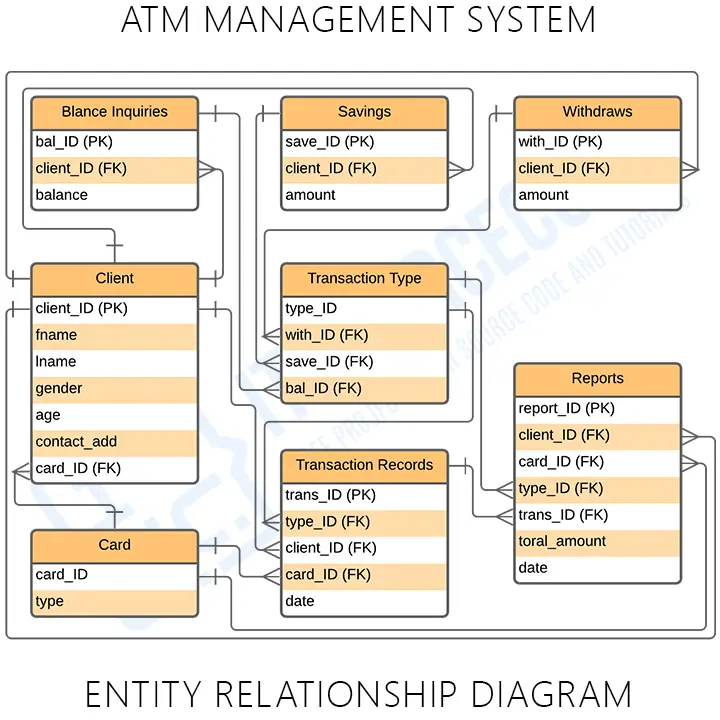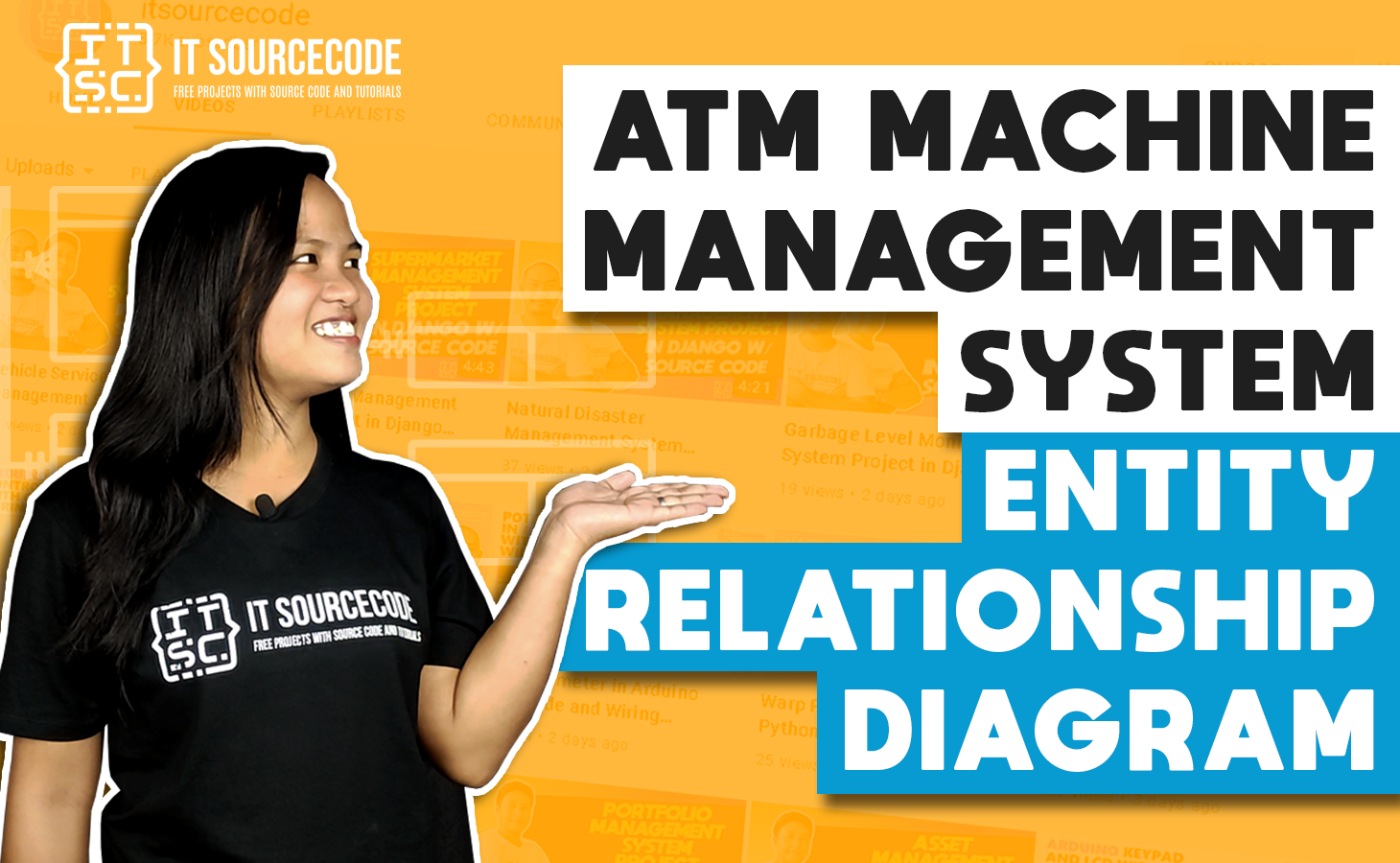The ER diagram for ATM management system shows the relationships of the ATM transaction and process entities that build its database design. This ER diagram is done by identifying the ATM transaction process entities, their properties, and the interactions between them.
To learn more about the ER Diagrams and more, check out the related and recommended articles below.
- ATM System UML Diagrams
- Activity Diagram for ATM Management System
- ER Diagram for Bank Management System
- ER Diagram for Order Management System
- ATM System Class Diagram | UML
- Online Examination System ER Diagram
- ER Diagram for Restaurant Management System
ER diagram for ATM management system details
The table shows the overall description of the ER Diagram for ATM System. It has a complete overview of the project’s information.
| Name: | ATM System ER Diagram |
| Abstract: | The ATM machine ER diagram depicts the relationship between various entities. It can be thought of as a blueprint for your system (project) structure. |
| Diagram: | ER Diagram is also known as Entity Relationship Diagram |
| Tools Used: | Diagraming tools that provide ER diagram symbols. |
| Designer: | ITSourceCode.com |
What is ATM System?
The ATM system is specialized software that aids in managing a bank account or holder’s funds simply. Users can check account balances, make cash withdrawals or deposits, print a record of account activities or transactions, and even purchase stamps via the system.
Customers can utilize the ATM system to conduct self-service transactions such as deposits, cash withdrawals, bill payments, and account transfers. The bank where the account is stored, the ATM operator, or both, frequently levy cash withdrawal fees.
ATM System Features
- ATM Machine Management – ATM management can keep track of the status and the transactions in the devices. It can also assist and help manage cash more efficiently, evaluate transaction data, spot potential fraud, keep track of transactions, and coordinate servicing.
- Customer Management – This feature aids banks in managing clients and better understanding their demands so that the proper solutions can be provided swiftly. This also enables the bank to identify, segment, communicate with, and create long-term relationships with clients on a per-customer basis.
- Manage Reports – This reports management will help the bank admin to have the timely and relevant information which are needed for monitoring purposes. It could also help in tracing every transaction done in the system. Managing the Reports will provide security to the valuable information that may be used to generate future projections and improve customer services.
- Manage Customer Transactions – Customer transactions management is in charge of creating and associating transaction activities up-to-date. This feature will also help the admin when there are issues on the customers’ side and ensure the given cards were all working.
- Transaction and Reports Management – This feature will store the transactions made by the customers including their information and the reports of every transaction and timetable.
What is an ER Diagram?
In DBMS, the ER Diagram of ATM machine system is also known as the ATM transaction process database design. It is the graphical depiction of relationships between all the entities involved in the system. Its major components are Entities, Attributes, and Relationships.
To build and troubleshoot relational databases, the ATM management system ER Diagram is used. It works best with DFD (Data Flow Diagram), which is responsible for data movement. Developing the database design for ATM system would be much easier with the help of ER diagram.
Importance of ER Diagram
The importance of ER diagram for ATM machine system is to help in modeling its data storage or database. It is the basis of the project’s database foundation for construction. The ATM system entity-relationship diagram (ERD) also aids in defining the data types to be stored such as their attributes and characteristics.
All other real-world projects are presented with ER Diagrams (database designs). To display the details and attributes of a data store, the er diagram for ATM management system is used in conjunction with its data flow diagram. It visualizes how data is connected generically.
ERD (Entity-relationship diagram) is utilized in software engineering during the planning phase of software development. It aids in the identification of various system constituents and their interrelationships. ATM Management System ERD is also used as the foundation of the ATM system DFD (Dataflow Diagram).
ER Diagram for ATM Management System
The ERD or ER Diagram for ATM System shows the system entity relationships in each entity and their supposed functions in each relationship. Now here’s the sample ER Diagram of ATM Management System.

Based on the image above, the Entity-Relationship (ER) Diagram for ATM Machine is the blueprint of the ATM Transaction Process database, and these are presented in tables. The tables are made to meet the required specification of the system and provide much more specific details of each entity within the system.
The purpose of this ER Diagram is to fully understand the ATM Management System as well as the relationships of tables in the project database design.
ATM Management System Database Design
This ATM System database design was made based on ATM processing requirements. The system can secure and monitor the activities or transactions of the card holders. The bank admin can have access to the clients’ status during checking of transactions. All in all, they can handle and secure the client’s every activity.
The features included in this ATM Management system’s ERD were the security and monitoring of the card holders’ transaction records and status. These features were also listed and recorded in reports that served as the history of all the activities done in the system.
ATM Management System ER Diagram Tables
These tables below provide the complete database table details such as Field Name, Descriptions, data types, and character lengths. Each of these tables represents the characteristics and the attributes of data storage.
The field column presents the names of each database’s attributes, the description column gives the complete thought of each attribute, the type column is their data type and the length is for their character lengths.
Table Name: Client
| Field | Description | Type | Length |
| client_ID (PK) | Client ID | Int | 11 |
| fname | Client First Name | Varchar | 255 |
| lname | Client Last Name | Int | 11 |
| gender | Client Gender | Text | |
| age | Client Age | Int | 11 |
| contact_add | Contact Address | Int | 11 |
Table Name: Card
| Field | Description | Type | Length |
| card_ID (PK) | Card ID | Int | 11 |
| card_number | Card Number | Int | 11 |
Table Name: Balance Inquiries
| Field | Description | Type | Length |
| bal_ID (PK) | Balance ID | Int | 11 |
| client_ID (FK) | Client ID | Int | 11 |
| card_ID (FK) | Card ID | Int | 11 |
| balance | Remaining Balance | Int | 11 |
Table Name: Withdraws
| Field | Description | Type | Length |
| with_ID (PK) | Withdraws ID | Int | 11 |
| client_ID (FK) | Client ID | Int | 11 |
| card_ID (FK) | Card ID | Int | 11 |
| Amount | Amount | Int | 11 |
Table Name: Savings
| Field | Description | Type | Length |
| save_ID (PK) | Withdraws ID | Int | 11 |
| client_ID (FK) | Client ID | Int | 11 |
| card_ID (FK) | Card ID | Int | 11 |
| Amount | Amount | Int | 11 |
Table Name: Transaction Records
| Field | Description | Type | Length |
| trans_ID (PK) | Transaction ID | Int | 11 |
| type_ID (FK) | Transaction Type | Int | 11 |
| client_ID (FK) | Client ID | Int | 11 |
| date | Date of Transaction | Date |
Table Name: Transaction Type
| Field | Description | Type | Length |
| type_ID (PK) | Transaction Type ID | Int | 11 |
| name_ID (FK) | Transaction Name ID | Int | 11 |
Table Name: Reports
| Field | Description | Type | Length |
| report_ID | Report ID | Int | 11 |
| client_ID (FK) | Client ID | Int | 11 |
| card_ID (FK) | Card ID | Int | 11 |
| trans_ID (FK) | Transaction ID | Int | 11 |
| type_ID (FK) | Type ID | Int | 11 |
| total_amount | Total Amount | Int | 11 |
| date | Date of Report | Date |
The tables given will be the basis for developers on how would they do the ATM management system database design. It has the complete description of the database and they will put this into the program or data storage the same as the names given to each of the tables. They will create a database with the attributes given as well as the value of each attribute.
ATM Management System ER Diagram [PDF]
The ER Diagram for ATM Management System in DBMS Pdf provides the information explaining the concepts of the project database. You may apply this information to your capstone project. You can also use it directly or modify its content depending on your project’s requirements.
How to create an ATM Management System ER Diagram
Time needed: 5 minutes
Here are the steps on how to create ATM Management System ER Diagram
- Step 1: Become acquainted with the ER Diagram (Entity Relationship Diagram). Symbols and Cardinality
The Entity Relationship Diagram shows the structure of data types in a project. It uses symbols to clarify its parts and relationships. Their symbols and applications must be familiar before you build the ER Diagram.
ER Diagram Symbols:
Fields are the parts of a table that define the entity’s characteristics. In the database that the ERD models, attributes are commonly thought of as rows.
Keys are a technique to categorize data quality. It is used to organize ER diagrams and assist users in modeling their databases to ensure that they are efficient. This is also used to connect different tables in a database.
A primary key identifies a single entity instance, which means a unique attribute or set of attributes.
A foreign key is produced when data attributes have one too many relationships with other entities. - Step 2: Complete the entities that will be included.
Begin designing your ER Diagram by finalizing your railway reservation system’s entities. These are rectangles. You must leave room in future phases so they can be incorporated.
- Step 3: Add the attributes of each entity
Upon finalizing the entities, analyze their attributes. As characteristics, ER diagram entities are described. All these are characteristics. Multivalued characteristics have several values.
- Step 4: Describe the relationships (cardinality) between entities and attributes
Entities, characteristics, and relationships are needed to draw ERD relationships. The data structure and entity relationship diagram are based on evaluated information.
Conclusion
ER (entity-relationship) diagram is only one of the diagrams used to design and develop the ATM Management System. Each of the diagrams you design and create will help you in presenting your ideas and impart your abilities.
Creating the ER diagram will help you perceive the back end of the software which will hold all the data that’ll enter and exit the system.
Inquiries
If you have inquiries or suggestions about ER Diagram for ATM System just leave us your comments below. We would be glad to know to concerns and suggestions and be part of your learning.
Keep us updated and Good day!

